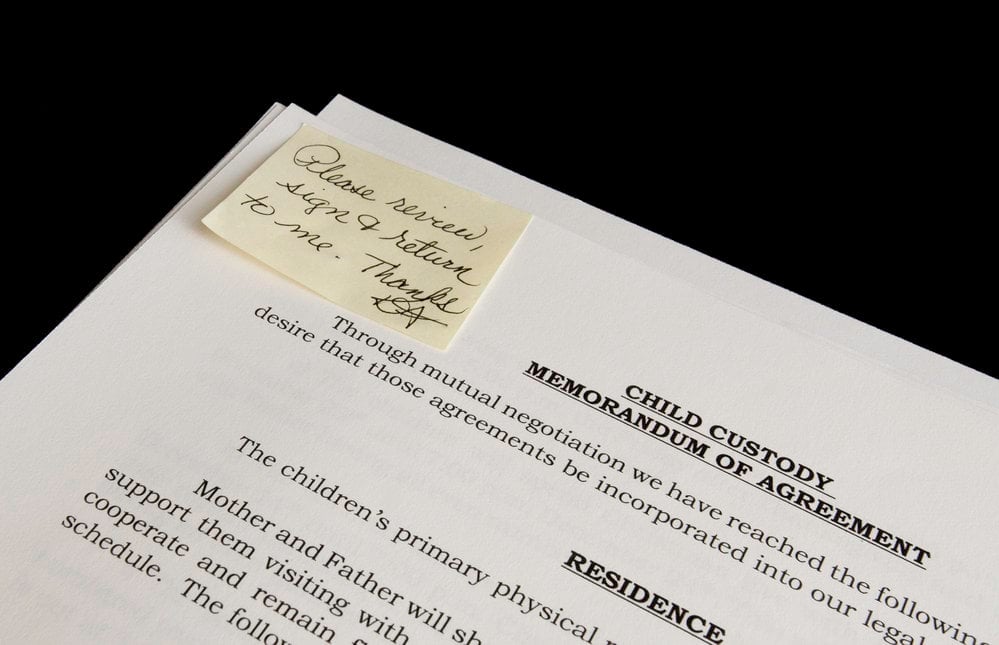Navigating the complex landscape of child custody agreements can be daunting for parents. Creating a comprehensive and well-thought-out agreement is essential to ensuring the best interests of the child or children involved. A custody agreement serves as a roadmap for parents navigating co-parenting, outlining how decisions will be made, the time each parent spends with the child, and financial responsibilities. It is important to carefully consider each aspect of the agreement to minimize conflicts and provide a stable environment for the child.
A custody agreement’s key components should address the child’s practical and emotional needs while strongly focusing on their overall well-being. Parent schedules, decision-making authority, financial responsibilities, communication strategies, and plans for addressing specific circumstances are included. Having a well-rounded agreement in place is vital for successful co-parenting.
It is important to remember that every family’s situation is unique, and flexibility is key to creating a custody agreement that works for everyone involved. Parents should not hesitate to seek professional assistance to navigate the intricacies of creating an effective custody agreement. The ultimate goal is to create an agreement that will serve the child’s best interests and foster a positive and cooperative co-parenting relationship.
Key Takeaways
- A comprehensive custody agreement is crucial for successful co-parenting and the child’s well-being.
- Parenting schedules, decision-making authority, and financial responsibilities are important to include.
- Seeking professional assistance, if needed, can help create an effective and unique custody agreement.

Key Components of a Custody Agreement
When creating a child custody agreement, it’s essential to consider the key components that will ensure the well-being and happiness of the child. This section will delve into the two crucial aspects of custody: Legal Custody and Physical Custody.
Legal Custody
Legal custody pertains to the authority to make essential decisions regarding the child’s upbringing, including their education, healthcare, and religious upbringing. There are two types of legal custody: joint custody and sole custody.
- Joint Custody: In this arrangement, both parents – the mother and the father – share the decision-making responsibilities for their child. Most courts often prefer it, as it encourages cooperation and consistency between the parents.
- Sole Custody: Alternatively, sole custody grants the decision-making authority to just one parent, the custodial parent. The non-custodial parent may still have visitation rights but won’t have the legal power to decide on the child’s upbringing.
It’s important to note that the court’s primary concern is the child’s best interests. Therefore, the legal custody decision will ultimately depend on the circumstances and the parent’s ability to cooperate effectively.
Physical Custody
Physical custody relates to the child’s living arrangements and time with each parent. Like legal custody, physical custody can be divided into joint and sole custody.
- Joint Physical Custody: Under joint physical custody, the child spends significant time with both parents. The exact schedule depends on the family’s needs and circumstances, but it usually includes splitting weekends, holidays, and weekdays as evenly as possible.
- Sole Physical Custody: If one parent, either the mother or the father, is granted sole physical custody, the child will reside primarily with that parent. In this situation, the non-custodial parent may still have visitation rights, allowing them to spend time with their child periodically.
It’s vital for the custody agreement to outline a clear and detailed schedule, factoring in school holidays, special occasions, and any changes that may occur in the parents’ lives.
To summarize, a well-drafted custody agreement considers legal and physical custody, ensuring the parents and the court prioritize the child’s best interests. Clear communication and cooperation between the parents will go a long way in creating a harmonious and nurturing environment for the child to grow and thrive.

Creating a Parenting Schedule
Regular Visitation
Crafting a parenting schedule can be challenging, but it’s crucial for parents and children. Establish a regular visitation schedule to meet everyone’s needs and expectations. Weekdays and weekends may have different routines, so consider alternating weekends and evenly distributing weekdays to guarantee each parent has ample time and involvement.
Furthermore, it’s essential to be flexible and make adjustments as needed. For example, incorporating both parents’ work schedules and extracurricular activities for the children can impact the routine. By developing a detailed and adaptable schedule, parents can demonstrate their shared dedication to the well-being of their children.
Holidays and Vacations
Ah, holidays and vacations—special times when families gather and bond! But without proper planning, these joyous occasions can cause stress for divorced or separated parents. To avoid disputes, delineate a plan for holidays and vacations within the parenting schedule. This may entail alternating major holidays, such as Thanksgiving and Christmas, or splitting holidays evenly.
Vacations offer a fantastic opportunity for parents to spend quality time with their children. Arranging vacation time in advance ensures that each parent can create precious memories while minimizing conflicts. Remember, communication is key when coordinating holiday and vacation plans.

Exchanges and Pick-up/Drop-off
When parents communicate effectively, exchanging custody becomes a smooth and straightforward process. But selecting suitable pick-up and drop-off locations can make all the difference! Ideally, these locations should be public, neutral, and accessible to both parents. Moreover, establishing consistent times for exchanges reduces confusion and helps foster a sense of stability for the children.
Practice empathy and exercise patience throughout the process—children may have mixed emotions during transitions. Thus, creating an environment of understanding and support can help maintain a positive atmosphere.
In conclusion, parents can create an organized and harmonious environment that enables their children to flourish by devising a comprehensive parenting schedule that covers regular visitation, holidays, vacations, and exchanges. Always remember the kids; they are the heart of any custody agreement.
Decision-Making Authority
In a custody agreement, defining decision-making authority is crucial to ensure the child’s welfare and reduce conflicts between parents. Let’s delve into specific areas, such as education, religion, medical care, and extracurricular activities.
Education
Regarding education, deciding on schools, academic programs, and special needs accommodations requires clear communication and parental cooperation. Divvying up responsibilities can be tricky, but it’s important to make sure that:
- Both parents are informed and involved in school-related decisions.
- A consensus is reached regarding private or public schooling and any associated expenses.
- At least one parent attends parent-teacher conferences and school events, or both if feasible.
A well-thought-out plan gives the child the best chance to excel academically and feel supported by both parents.
Religion
Religion plays a significant role in many families, so it’s vital for parents in a custody agreement to find common ground in this area. Establishing guidelines around religious practices can help prevent potential conflicts, so consider the following:
- Agreeing on the child’s religious upbringing, whether embracing one parent’s beliefs or blending both.
- Decide who will enroll the child in religious education classes or activities.
- Ensuring mutual respect for each parent’s belief system, even if they differ or change over time.
Creating a consistent spiritual environment for a child may make them feel understood and loved by both parents.
Medical Care
Parents should agree on healthcare providers, treatments, and important decisions regarding medical care. To ensure optimum health and well-being for a child, consider the following:
- Making joint decisions regarding primary care providers, specialists, and medical treatments.
- Establishing guidelines for managing emergencies or urgent situations.
- Ensure parents are promptly informed about health concerns, appointments, and treatment plans.
Having a unified approach to medical care is fundamental for the emotional and physical well-being of the child.
Extracurricular Activities
For a balanced life, extracurricular activities contribute immensely to a child’s growth and development. To make informed decisions about a child’s interests and hobbies, parents should:
- Agree on pursuing certain activities, ensuring the child’s preferences are considered.
- Determine which parent will be responsible for enrollment and associated costs.
- Arrange for parents to attend events, competitions, or performances, supporting the child.
In conclusion, decision-making authority is a vital aspect of a custody agreement. By addressing these details, parents can create an environment of collaboration that fosters the child’s growth and well-being across all aspects of life.

Child Support and Financial Responsibilities
Child Support Payments
When creating a custody agreement, addressing child support payments is essential. These payments are vital to maintaining the child’s well-being and lifestyle. Generally, the non-custodial parent contributes a certain amount each month to the custodial parent. Factors determining the amount include parents’ income levels, the child’s needs, and the time spent with each parent. It’s crucial to agree upon a payment schedule and methods to make it easier for both parties.
Medical Expenses
Healthcare is a vital aspect of a child’s life. It’s crucial to plan for unforeseen medical expenses. A custody agreement should outline each parent’s responsibility for medical costs, including insurance co-pays, deductibles, and out-of-pocket expenses. Additionally, consider allocating a specific percentage for each parent to contribute towards the expenses, ensuring fairness and cooperation in your child’s well-being.
Insurance
Insurance coverage plays a crucial role in easing the financial burden of medical expenses, so address it in your custody agreement. Specifying the type of insurance — health, dental, or vision — each parent will provide for the child is important. Furthermore, the agreement should stipulate the responsible party for maintaining the premiums and ensuring no lapses in coverage.
Child Care and Education Costs
Child care and education are pivotal to a child’s growth and development. In the custody agreement, discuss how both parents will share the expenses for child care, after-school activities, tutoring, and college savings. It’s also beneficial to establish a shared parenting plan, outlining how each parent will contribute to important educational decisions and milestones.
Addressing child support and financial responsibilities in your custody agreement creates a stable environment for your child’s growth and well-being. Involving both parents in these decisions fosters cooperation and helps you maintain a practical, collaborative approach to co-parenting.
Communication and Conflict Resolution
Co-Parenting Communication
Effective co-parenting communication is crucial in any custody agreement. It lets both parents stay informed and engaged in their child’s life. Establish clear protocols for sharing information about the child’s well-being, schooling, and activities to ensure smooth communication. Tools like shared calendars, phone calls, and messaging apps can be useful. Additionally, agreeing on a respectful communication style helps prevent misunderstandings and maintain a cordial relationship.
Dispute Resolution Processes
Conflicts can inevitably arise between co-parents. A solid custody agreement should outline dispute resolution processes in such scenarios. This can include engaging in open discussions, exchanging written agreements, and consulting a neutral third party. A clear process can mitigate contentious situations, and co-parents can avoid legal battles detrimental to everyone involved.
Mediation and Negotiation
Co-parents should consider mediation and negotiation as the next step in their conflict resolution plan when disputes cannot be resolved through direct communication. Mediation involves a trained, neutral mediator who assists both parties in finding a mutually agreeable solution. On the other hand, negotiation entails each parent presenting their concerns and working towards a compromise.
Co-parents create a framework to address and resolve conflicts constructively by incorporating these methods into a custody agreement. Ultimately, this contributes to a healthier co-parenting relationship and promotes the child’s best interests.

Addressing Specific Circumstances
In certain situations, custody agreements might need to consider unique circumstances. This section will delve into such situations and guide drafting a solid custody agreement.
Separated or Unmarried Parents
When dealing with separated or unmarried parents, it’s crucial to establish a co-parenting plan that addresses each parent’s rights and responsibilities. In such cases, consider the following:
- Clearly define each parent’s custody and visitation schedule.
- Specify decision-making authority for vital matters, such as healthcare, education, and religious upbringing.
- Make arrangements for child support, considering each parent’s income and the child’s needs.
Relocation and Jurisdiction Issues
Relocation can complicate custody agreements in a world where people are always on the move. To address relocation and jurisdiction concerns, consider the following:
- State clear terms for notification and consent if a parent wishes to relocate with the child.
- Disclose the child’s primary residence so that jurisdictional issues can be clearly defined.
- If parents live in separate states or countries, specify the governing laws and jurisdiction for handling disputes.
Involvement of Grandparents and Extended Family
The role of grandparents and extended family members can significantly influence a child’s life. It’s essential to recognize their involvement when crafting a custody agreement. Some considerations are:
- Determine the communication and visitation rights of the grandparents and extended family.
- Outline protocols for holidays, vacations, and special events to include extended family members.
- Encourage parents to support and promote healthy relationships between the child and their extended family.
Addressing these specific circumstances can create a comprehensive custody agreement that considers all parties involved, ensuring the child’s well-being and happiness.
Modifications and Enforcements
Modification Process
Ah, the twists and turns of life! It’s essential to understand that custody agreements may need modifications as circumstances change. To begin the modification process, one or both parents must petition the court for a reevaluation. A judge will carefully review the situation, considering the child’s best interests before making any alterations. It’s important to note that changes aren’t granted on a whim – there must be a significant reason for modifying the custody agreement.
Of course, the key to making this process smoother lies in communication. Parents who can maintain open and respectful discussions with one another are more likely to find common ground when seeking modifications. Remember, it’s not about winning or losing; it’s about ensuring the child’s well-being and happiness.
Enforcement of Court Orders
Let’s face it: not everyone follows the rules. When court orders are ignored or disobeyed, enforcement comes into play. It’s crucial to understand that enforcement is separate from modification, and the goal is to uphold the existing custody agreement.
In such cases, a judge will review the situation and may impose penalties if a parent is found to violate the court order. Consequences can vary but often include fines and potential changes to the custody agreement.
To avoid finding yourself in a sticky situation, always adhere to the court order and communicate openly with the other parent. With the right attitude and cooperation, you can ensure a stable and nurturing environment for your child to flourish.
Additional Provisions
Safety Measures
It’s crucial to prioritize safety in a custody agreement. Parents must outline clear guidelines to ensure their child’s well-being. For instance, discuss emergency contact information, medical concerns, and how to handle unforeseen circumstances. Both parents protect their child’s best interests by establishing common ground on safety measures.
Additionally, parents should decide on communication methods and regular check-ins. Incorporating technology, such as phone calls or video chats, can provide a sense of security and connection between the child and the non-custodial parent.
Responsibilities for Babysitters and Daycare
Child care is essential to custody agreements, but choosing the right caregiver requires a team effort. Parents must collaborate to determine several caregiving responsibilities:
- Selection process: Agree on criteria for choosing babysitters and daycare facilities, such as experience, background checks, and location. Drafting guidelines minimize potential confusion or disputes later on.
- Sharing information: Exchange contacts, schedules, and other pertinent details concerning the child’s caregivers. This information ensures a seamless handover, informing each parent of the child’s surroundings and caregivers’ qualifications.
- Decision-making: Establish a decision-making process for selecting caregivers and addressing any concerns. Doing so fosters mutual understanding between parents and encourages a harmonious co-parenting relationship.
In conclusion, prioritizing safety measures and proper child care in a custody agreement is paramount for a child’s well-being. By outlining additional provisions such as safety measures, responsibilities for babysitters, and daycare providers, parents can ensure a smooth, nurturing, and secure environment for their children.
Seeking Professional Assistance
When crafting a custody agreement, having the right support on your side is crucial. It’s not always easy to navigate the murky waters of custody disputes, so enlisting the help of experienced professionals can make all the difference. This section delves into three essential resources: Family Law Attorneys, Law Firms, and Mediation Services.
Family Law Attorneys
A family law attorney is a savior in times of need. They have the knowledge and expertise to guide you through the legal process, ensuring your rights are protected. These skilled legal professionals can provide invaluable advice on custody, visitation, and support issues, helping to create an agreement that meets your child’s best interests.
Here’s what a family law attorney can offer:
- Assess and evaluate your case
- Educate you on the legal rights and obligations
- Draft, review, and modify custody agreements
- Represent you in court, if necessary
Remember, choosing an attorney whose style and approach align with your needs is essential. Trust and compatibility are vital in this relationship.
Law Firms
Law firms have entire teams dedicated to resolving custody disputes. They boast a cadre of legal experts proficient in family law, granting extra proficiency and resources. With a law firm in your corner, you can rest assured that your case will get the attention it deserves.
These are some of the benefits of hiring a law firm:
- Access to a wide array of legal specialists
- Efficient handling of legal paperwork
- A comprehensive strategy for your case
- Continuous support and guidance
Do your research and find a reputable law firm with a proven track record in dealing with custody agreements.
Mediation Services
In certain situations, opting for mediation services may be more beneficial. Mediation is a cooperative, problem-solving process that encourages open dialogue between parties. A neutral mediator will assist in reaching a fair and mutually satisfactory agreement, with the child’s well-being as the central focus.
Here are some reasons to consider mediation:
- Cost-effective and quicker than going to court
- Creates a positive environment for communication
- Encourages cooperation in the decision-making process
- Preserves relationships by reducing conflict
Remember that mediation is most effective when both parties are open to communication and compromise. Sometimes, it can even be used alongside legal representation for the best possible outcome.
FAQs
When it comes to custody agreements, many questions often arise. Here are some frequently asked questions and their answers to help guide you through this process.
What is a custody agreement?
A custody agreement is a legal document that outlines how parents will share the responsibility of raising their children after separation or divorce. It includes details about physical custody, legal custody, visitation schedules, and other important aspects concerning the child’s well-being.
What should be included in a custody agreement?
A comprehensive custody agreement should cover various aspects, such as:
- Physical custody (who the child will live with)
- Legal custody (who makes decisions for the child)
- Visitation and parenting time schedules
- Holidays, vacations, and special occasions
- Child support payments and financial responsibilities
- Medical care, health insurance, and educational expenses
- Communication between parents and the decision-making process
How is a custody agreement enforced?
A custody agreement becomes legally binding once a judge approves and signs it. If either parent violates the agreement, the other can file a motion with the court to enforce the terms. Judges take such violations seriously and may impose fines, modify the agreement, or even change custody arrangements.
Can custody agreements be modified?
Yes, custody agreements can be modified if there’s a significant change in circumstances or if both parents mutually agree to the changes. To modify an existing agreement, a motion must be filed with the court detailing the reasons for the proposed changes. If the court finds the modifications in the child’s best interest, the judge will approve the changes and update the custody agreement.
Remember, the primary goal of any custody agreement is to ensure the child’s best interests are met. You’ll be better equipped to create a well-rounded and effective custody agreement by addressing the most common questions and concerns.

